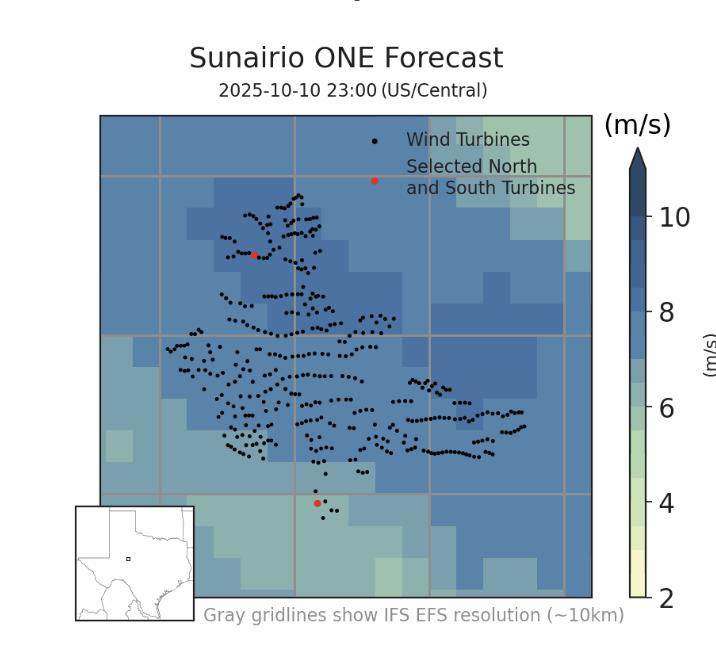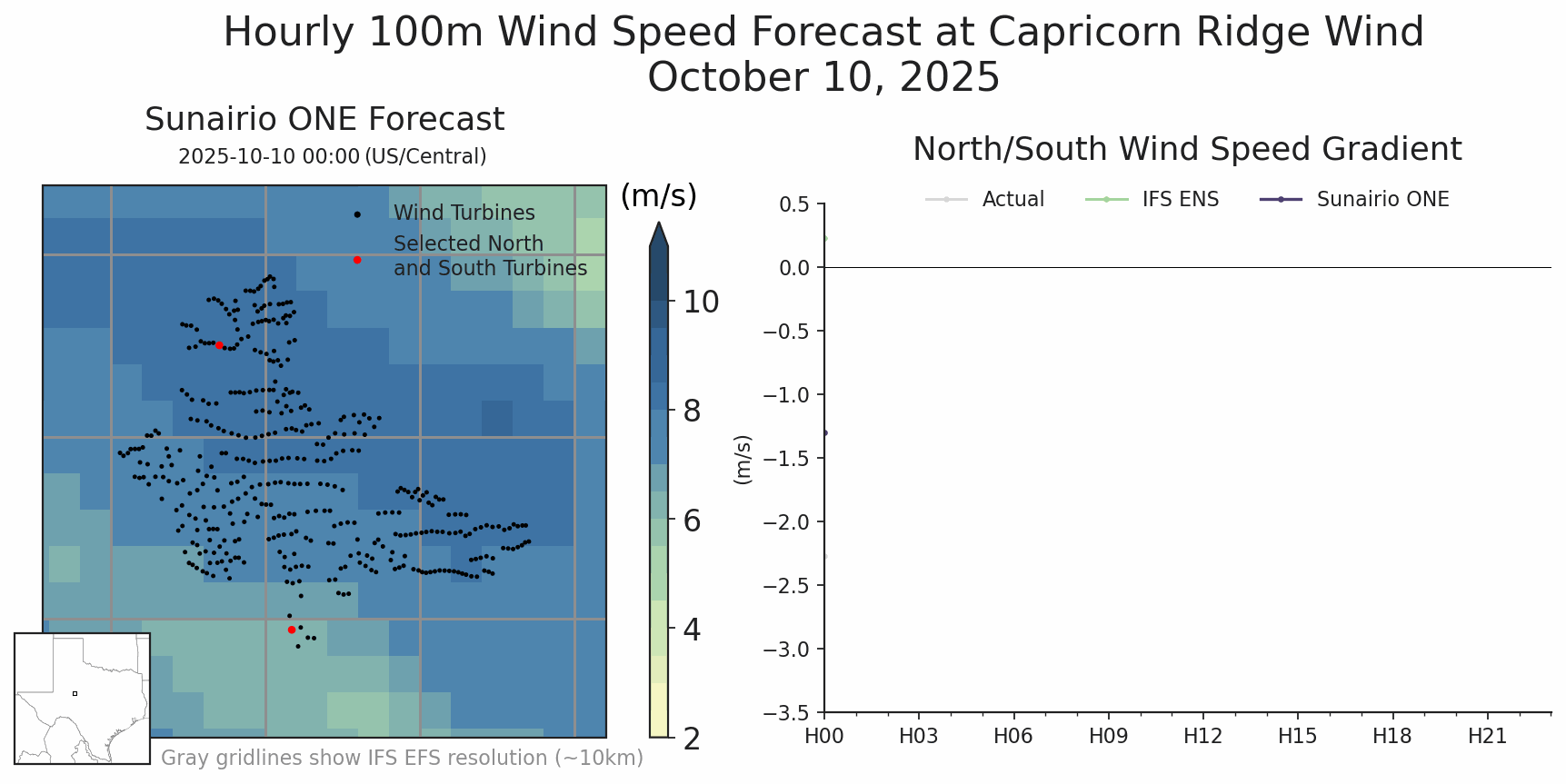
This is the second blog post in our three-part series that explores key areas where Sunairio’s Omniscale Next-generation Ensemble (ONE) forecast model outperforms traditional solutions. Our first blog post demonstrated that Sunairio ONE was more calibrated, sharp, and extremes-conspicuous than legacy ensemble methods. Here, we show that Sunairio ONE’s high spatial resolution captures local variability of wind speeds better than existing models and demonstrate how that wind speed gradient can translate to a large variation in expected power output.
Variable renewable energy assets like utility-scale wind and solar farms experience meaningful fluctuations in power output as local weather conditions change. However, most weather forecasts aren’t generated at a spatial or temporal granularity that’s sufficient to accurately anticipate those dynamics. In the case of wind, for example, detailed topographical features and their resulting phenomena (e.g., terrain-induced waking or speed-up effects) are lost at coarse resolutions1. Sunairio ONE addresses these challenges by providing a high resolution weather forecast, which captures small-scale variability, enabling best-in-class asset-level generation potential forecasts.
Asset-level wind energy forecasting requires both highly-accurate weather forecasts of mesoscale wind (on the order of a few km) and sophisticated models of wind field dynamics within the wind farm footprint, which are affected by many factors including terrain, vegetation cover, and turbine waking.
In fact, we find that wind energy modeling best practices dictate separating this problem into three stages: 1) the mesoscale free-field wind2 forecast, 2) the microscale wind field within the wind farm footprint (less than 1km effects usually influenced by terrain), and 3) turbine-by-turbine waking (Figure 1).

Figure 1. Diagram showing three mains steps involved in accurate modeling wind energy at a wind farm.
Sunairio has already pioneered novel solutions to Steps 2 and 3, previously reporting on our use of highly-efficient CFD models to model turbine-scale (100m) wind fields and waking for all operational wind farms in the U.S.
We are now excited to leverage Sunairio ONE, our high-resolution ensemble weather forecast, to improve mesoscale wind forecasting for asset-level generation.
Surveying the landscape of publicly available weather models that can provide mesoscale free-field wind forecasts shows that none offer truly high spatial and temporal resolution output that extend beyond a few hours (Table 1). Furthermore, Figure 2 helps provide some scale to the current problem, comparing the spatial resolution of Sunairio ONE (at approximately 2km) and the IFS (at approximately 10km) against actual wind farm footprints in ERCOT. Mesoscale forecasting at 10km (like the IFS) vs. 2km may average out important wind gradients that vary over a wind farm and lead to exponential wind generation errors (more on this below).
Additionally, Sunairio ONE forecasts are generated at hourly temporal resolution–critical for energy forecasting applications–for the full forecast period; no other major publicly available forecast model does this. For example, the IFS starts at hourly resolution for the first three to four days but then drops to 3-hourly and 6-hourly steps as it gets further out.
| Forecast Model | Outlook Period | Temporal Resolution | Spatial Resolution | |
| HRRR (NOAA) | 48 hours3 | 1-hourly | ~ | 3km |
| GFS/GEFS (NOAA) | 16 days | 0-120 at 1-hourly 123-384 at 3-hourly | 0.25° | ~28km |
| IFS/IFS ENS (ECMWF) | 15 days | 0-90 at 1-hourly 93-144 at 3-hourly 150-360 at 6-hourly | 0.1° | ~10km |
| AIFS/AIFS ENS (ECMWF) | 15 days | 0-360 at 6-hourly | 0.25° | ~28km |
| Sunairio ONE | 15 years | 1-hourly | 0.02° | ~2km |
Table 1. Comparison of forecast models by outlook period, temporal resolution, and spatial resolution.

Figure 2. Zoomed area of map of wind farms in Texas (shaded bounding boxes show footprints of wind turbines at wind farms).
To visualize just how important it is to capture variations in free-field wind forecasts, we analyzed a day of wind forecast performance (three days out) between Sunairio ONE and the IFS across a major ERCOT wind farm, Capricorn Ridge. As Figure 3 shows, the difference between wind speeds at the north end of the farm compared to the south end (turbines marked in red in left panel) were as great as 3 m/s in some hours. While Sunairio ONE successfully forecasted this wind field gradient (right panel), the lower-resolution IFS could not resolve the proper dynamics, instead seeing a fairly uniform wind field.

Figure 3. (Left panel): Map of Sunairio ONE forecasted wind speed across a wind farm in Texas over a 24-hour period; (Right panel): Line plot tracking the wind speed gradient (i.e., difference in wind speeds) from the north side to the south side of the farm compared toSunairio ONE 3-day ahead forecast and IFS ENS 3-day ahead forecast.
Does a 3 m/s gradient in free-field wind speed over a wind farm really matter? Depending on the absolute wind speed levels, it can matter immensely. Below their rated capacity, wind turbine power output scales cubically with wind speed which causes even seemingly minor variations in wind speed to lead to large differences in generation potential. Turning to Figure 4, we plot an example power curve of a 1.5 MW turbine, which represents the majority of turbines at Capricorn Ridge. A difference of 3 m/s in wind speed can translate to up to a 959 kW delta in power output, or 64% of rated capacity!

Figure 4. Power curve for the 1.5 MW wind turbines that comprise the Capricorn Ridge Farm. 3 m/s wind speed gradients can translate to power differences as large as 959 kW.
Over a wind farm with hundreds of turbines, the impact of modeling wind speeds at a lower resolution on generation potential forecast performance can quickly add up.
Accurately forecasting local wind speeds is essential for creating reliable forecasts of asset-level generation. Sunairio ONE provides 2km spatial resolution, hourly temporal resolution forecasts that are ideally suited to serve as the critical free-field wind forecast step in wind farm generation modeling pipelines.